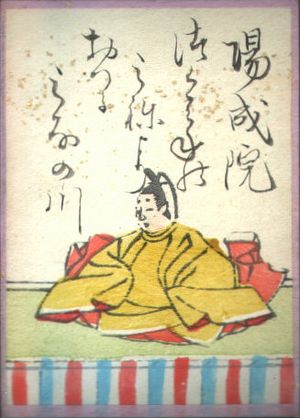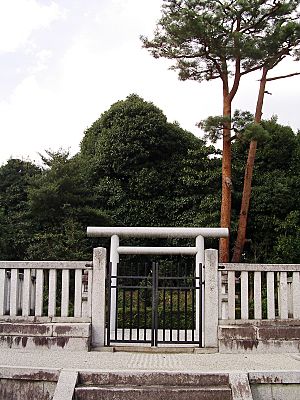Emperor Yōzei facts for kids
Quick facts for kids Emperor Yōzei陽成天皇 |
|||||
|---|---|---|---|---|---|

(from the Ogura Hyakunin Isshu)
|
|||||
| Emperor of Japan | |||||
| Reign | December 18, 876 – March 4, 884 | ||||
| Coronation | January 20, 877 | ||||
| Predecessor | Seiwa | ||||
| Successor | Kōkō | ||||
| Born | January 2, 869 Somedono In, Heian Kyō (Kyōto) |
||||
| Died | October 23, 949 (aged 80) Heian Kyō (Kyōto) |
||||
| Burial | Kaguragaoka no Higashi no misasagi (神楽岡東陵) (Kyōto) | ||||
| Issue |
|
||||
|
|||||
| House | Yamato | ||||
| Father | Emperor Seiwa | ||||
| Mother | Fujiwara no Takaiko | ||||
Emperor Yōzei (陽成天皇, Yōzei-tennō) was the 57th emperor of Japan. He was born on January 2, 869, and passed away on October 23, 949. His time as emperor lasted from 876 to 884.
Becoming Emperor: Yōzei's Early Life
Before he became emperor, his personal name was Sadaakira Shinnō (貞明親王). Yōzei was the oldest son of Emperor Seiwa. His mother was Empress Fujiwara no Takaiko. She was also known as the Nijō empress after Emperor Seiwa stepped down.
Yōzei's mother was the sister of Fujiwara no Mototsune. Mototsune would play a very important role in the young emperor's life.
In ancient Japan, there were four main noble families. One of these was the Minamoto clan (源氏), also known as Genji. Some members of the Yōzei Genji (陽成源氏) family are descendants of Emperor Yōzei.
Yōzei had nine imperial children. They were born after he was no longer emperor.
Important Events During Yōzei's Reign
Yōzei became emperor when he was still a very young boy. Here are some key events from his life:
- 869: Yōzei was born. The next year, he was named Emperor Seiwa's heir.
- December 18, 876: Emperor Seiwa gave up his throne to his son. This meant that young Yōzei became the new emperor.
- January 20, 877: Yōzei was officially crowned emperor when he was 8 years old. A new era name, Gangyō, was announced.
- 877: Ambassadors from Baekje (an ancient Korean kingdom) arrived in Japan. However, they were sent back.
- 877: There was a big drought. People made offerings at temples like Hachiman and Kamo to ask for rain. Eventually, it rained.
Challenges and Changes in Leadership
As Yōzei entered his teenage years, his behavior became a concern. He enjoyed watching animals fight and sometimes acted in ways that worried those around him. He also became very angry at times.
Fujiwara no Mototsune, who was a chief advisor to the emperor, tried to guide Yōzei. However, the emperor did not listen to his advice.
- 884: Yōzei's actions became more extreme. Mototsune saw that Yōzei had ordered men to climb trees and then be poked with spears until they fell. This event convinced Mototsune that Yōzei was not fit to rule.
Mototsune decided that the emperor needed to be removed from the throne. He tricked Yōzei into leaving the palace by suggesting a horse race.
- March 4, 884: Yōzei was taken in a carriage to another palace. There, Mototsune told him that his behavior made him unable to rule. Yōzei was removed from his position as emperor.
Records from that time suggest that Emperor Yōzei may have caused harm to one of his servants. In ancient Japan, such actions were seen as very serious and "unclean." This was especially true for the emperor, who was considered a divine figure. Many court officials believed that Yōzei's actions were unacceptable. They felt it was necessary to remove him from the throne.
A historian named Kitabatake Chikafusa wrote in the 14th century that Emperor Yōzei had a "violent personality." He believed Yōzei was not suitable to be a ruler. When Fujiwara no Mototsune decided to remove Yōzei, many important officials agreed.
Yōzei was succeeded by his father's uncle, Emperor Kōkō.
Life After the Throne
Even after being removed from the throne, Yōzei continued to face challenges.
- 889: The former emperor Yōzei experienced further difficulties with his mental health. He would sometimes enter the palace and act rudely towards people. He was also known to harm others and animals.
Yōzei lived a long life in retirement. He passed away at the age of 80.
The exact location of Yōzei's grave is known. This emperor is honored at a special Shinto shrine and mausoleum in Kyoto. The Imperial Household Agency officially calls this place Kaguragaoka no Higashi no misasagi.
Eras During Yōzei's Reign
In Japan, years are grouped into periods called nengō or era names. During Yōzei's time, the way these era names were chosen began to change. Instead of always being named after good omens, they sometimes were chosen to try and lessen the effects of bad events.
The eras during Yōzei's reign were:
See also
 In Spanish: Yōzei Tennō para niños
In Spanish: Yōzei Tennō para niños
- Emperor of Japan
- List of Emperors of Japan
- Imperial cult
| Regnal titles | ||
|---|---|---|
| Preceded by Emperor Seiwa |
Emperor of Japan: Yōzei 876–884 |
Succeeded by Emperor Kōkō |


